
Learn multiplication and division.
- Subject:
- Career & Work Exploration
- Practical & Applied Arts
- Material Type:
- Activity/Lab
- Lesson
- Provider:
- Goodwill Community Foundation, Inc.
- Provider Set:
- GCFLearnFree
- Date Added:
- 05/10/2018

Learn multiplication and division.

This short video and interactive assessment activity is designed to teach fourth graders about shortening multiplication expressions.

This short video and interactive assessment activity is designed to teach fourth graders about multiplying 2-digit by 2-digit numbers in columns.

This short video and interactive assessment activity is designed to teach fourth graders about comparing using greater than, less than, and equal to.

(Nota: Esta es una traducción de un recurso educativo abierto creado por el Departamento de Educación del Estado de Nueva York (NYSED) como parte del proyecto "EngageNY" en 2013. Aunque el recurso real fue traducido por personas, la siguiente descripción se tradujo del inglés original usando Google Translate para ayudar a los usuarios potenciales a decidir si se adapta a sus necesidades y puede contener errores gramaticales o lingüísticos. La descripción original en inglés también se proporciona a continuación.)
Este módulo de 25 días se basa directamente en los estudiantes que trabajan con multiplicación y división en el módulo 1. El módulo 3 extiende el estudio de factores de 2, 3, 4, 5 y 10 para incluir todas las unidades de 0 a 10, así como múltiples de 10 dentro de 100. Similar a la organización del Módulo 1, la introducción de nuevos factores en el módulo 3 se extiende a través de temas. Esto permite a los estudiantes construir fluidez con hechos que involucran una unidad en particular antes de continuar. Los factores están secuenciados para facilitar la instrucción sistemática con estrategias y patrones cada vez más sofisticados.
Encuentre el resto de los recursos matemáticos de Engageny en https://archive.org/details/engageny-mathematics.
English Description:
This 25-day module builds directly on students work with multiplication and division in Module 1. Module 3 extends the study of factors from 2, 3, 4, 5, and 10 to include all units from 0 to 10, as well as multiples of 10 within 100. Similar to the organization of Module 1, the introduction of new factors in Module 3 spreads across topics. This allows students to build fluency with facts involving a particular unit before moving on. The factors are sequenced to facilitate systematic instruction with increasingly sophisticated strategies and patterns.
Find the rest of the EngageNY Mathematics resources at https://archive.org/details/engageny-mathematics.
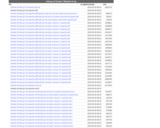
(Nota: Esta es una traducción de un recurso educativo abierto creado por el Departamento de Educación del Estado de Nueva York (NYSED) como parte del proyecto "EngageNY" en 2013. Aunque el recurso real fue traducido por personas, la siguiente descripción se tradujo del inglés original usando Google Translate para ayudar a los usuarios potenciales a decidir si se adapta a sus necesidades y puede contener errores gramaticales o lingüísticos. La descripción original en inglés también se proporciona a continuación.)
El módulo 6 establece la base conceptual para la multiplicación y la división en el grado 3 y para la idea de que los números distintos de 1, 10 y 100 pueden servir como unidades. Los temas en este módulo incluyen: formación de grupos iguales, matrices y grupos iguales, matrices rectangulares como base para la multiplicación y división, y el significado de números par y impares.
Encuentre el resto de los recursos matemáticos de Engageny en https://archive.org/details/engageny-mathematics.
English Description:
Module 6 lays the conceptual foundation for multiplication and division in Grade 3 and for the idea that numbers other than 1, 10, and 100 can serve as units. Topics in this module include: Formation of Equal Groups, Arrays and Equal Groups, Rectangular Arrays as a Foundation for Multiplication and Division, and The Meaning of Even and Odd Numbers.
Find the rest of the EngageNY Mathematics resources at https://archive.org/details/engageny-mathematics.
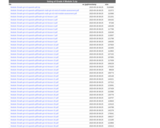
(Nota: Esta es una traducción de un recurso educativo abierto creado por el Departamento de Educación del Estado de Nueva York (NYSED) como parte del proyecto "EngageNY" en 2013. Aunque el recurso real fue traducido por personas, la siguiente descripción se tradujo del inglés original usando Google Translate para ayudar a los usuarios potenciales a decidir si se adapta a sus necesidades y puede contener errores gramaticales o lingüísticos. La descripción original en inglés también se proporciona a continuación.)
En este módulo de 43 días, los estudiantes usan la comprensión del valor del lugar y las representaciones visuales para resolver problemas de multiplicación y división con números de múltiples dígitos. Como área clave de enfoque para el grado 4, este módulo se mueve lenta pero exhaustivamente para desarrollar la capacidad de los estudiantes para razonar sobre los métodos y modelos elegidos para resolver problemas con factores y dividendos de múltiples dígitos.
Encuentre el resto de los recursos matemáticos de Engageny en https://archive.org/details/engageny-mathematics.
English Description:
In this 43-day module, students use place value understanding and visual representations to solve multiplication and division problems with multi-digit numbers. As a key area of focus for Grade 4, this module moves slowly but comprehensively to develop students ability to reason about the methods and models chosen to solve problems with multi-digit factors and dividends.
Find the rest of the EngageNY Mathematics resources at https://archive.org/details/engageny-mathematics.

(Nota: Esta es una traducción de un recurso educativo abierto creado por el Departamento de Educación del Estado de Nueva York (NYSED) como parte del proyecto "EngageNY" en 2013. Aunque el recurso real fue traducido por personas, la siguiente descripción se tradujo del inglés original usando Google Translate para ayudar a los usuarios potenciales a decidir si se adapta a sus necesidades y puede contener errores gramaticales o lingüísticos. La descripción original en inglés también se proporciona a continuación.)
Módulo 4 de grado 5 extiende la comprensión del estudiante de las operaciones de fracción a la multiplicación y la división de fracciones y fracciones decimales. El trabajo procede de la interpretación de los gráficos de línea que incluyen mediciones fraccionales para interpretar las fracciones como división y razonamiento sobre la búsqueda de fracciones de conjuntos a través de la fracción por multiplicación de números enteros. El módulo procede a la fracción por multiplicación de fracción en formas de fracción y decimal. Una comprensión de la multiplicación como escala y multiplicación por N/N como multiplicación por 1 permite a los estudiantes razonar sobre productos y convertir fracciones en decimales y viceversa. Los estudiantes son presentados al trabajo de división con fracciones y fracciones decimales. Los casos de división se limitan a la división de números enteros por fracciones unitarias y fracciones unitarias por números enteros. Se introducen divisores de fracción decimal y la fracción equivalente y el pensamiento del valor del lugar permiten al alumno razonar sobre el tamaño de los cocientes, calcular los cocientes y colocar decimales con sensatez en los cocientes. A lo largo del módulo, se les pide a los estudiantes que razonen sobre estos conceptos importantes interpretando expresiones numéricas que incluyen operaciones de fracción y decimales y perseverar en la resolución de problemas de varios pasos en el mundo real que incluyen todas las operaciones de fracción compatibles con el uso de diagramas de cintas.
Encuentre el resto de los recursos matemáticos de Engageny en https://archive.org/details/engageny-mathematics.
English Description:
Grade 5s Module 4 extends student understanding of fraction operations to multiplication and division of both fractions and decimal fractions. Work proceeds from interpretation of line plots which include fractional measurements to interpreting fractions as division and reasoning about finding fractions of sets through fraction by whole number multiplication. The module proceeds to fraction by fraction multiplication in both fraction and decimal forms. An understanding of multiplication as scaling and multiplication by n/n as multiplication by 1 allows students to reason about products and convert fractions to decimals and vice versa. Students are introduced to the work of division with fractions and decimal fractions. Division cases are limited to division of whole numbers by unit fractions and unit fractions by whole numbers. Decimal fraction divisors are introduced and equivalent fraction and place value thinking allow student to reason about the size of quotients, calculate quotients and sensibly place decimals in quotients. Throughout the module students are asked to reason about these important concepts by interpreting numerical expressions which include fraction and decimal operations and by persevering in solving real-world, multistep problems which include all fraction operations supported by the use of tape diagrams.
Find the rest of the EngageNY Mathematics resources at https://archive.org/details/engageny-mathematics.

Ce site offre des exercices éducatifs pour tous!
Cette dernière version du site vous permet d'effectuer plus de 1250 exercices en ligne, la variété et la qualité de nos exercices sont appréciés les mois "scolaires" par plus de 200.000 "visiteurs uniques".
Le Collège Technique Saint-Henri de Mouscron nous aide pour financer l'hébergement Internet, ce qui nous permet de mettre à votre disposition gratuitement l'ensemble des exercices sur un site exempt de publicités.
**numératie et littératie

This short video and interactive assessment activity is designed to teach third graders about division patterns within the multiplication table.

This short video and interactive assessment activity is designed to teach fourth graders about patterns in division by 6, 7, 8, 9, 11, 12.

Pet Bingo is a whimsical mathematical world for everyone! Come watch your child’s understanding of addition, subtraction, multiplication and division grow with their very own pets! Feed your pets and your child’s minds!
Pet Bingo features the following K-4 math skills:
ADDITION & SUBTRACTION:
– Add and subtract up to 10, 20, 100, 1000 and more
– Add up to four digit numbers
– Add and subtract multi-digit whole numbers
MULTIPLICATION & DIVISION:
– Practice times tables 1 to 12
– Multiply and divide by 100
– Multiply whole numbers by 10
MEASUREMENT/GEOMETRY:
– Represent whole numbers on an equally spaced numberline
– Understand concepts of area and relation to multiplication and addition

This short video and interactive assessment activity is designed to teach fourth graders about using both division and multiplication - word problems.
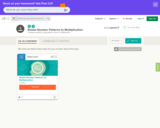
This short video and interactive assessment activity is designed to teach fourth graders about patterns without using multiplication.

This short video and interactive assessment activity is designed to teach fourth graders about express the sentence and calculate - division.

Same But Different is a powerful routine for use in math classrooms. The activity of same but different is an activity where two things are compared, calling attention to both how they are the same and how they are different.
This apparent paradox is the beauty of the activity. It is important to notice the word BUT. Instead of making a choice – am I going to prove that these are the same or am I going to prove that they are different – students are considering how two items can be both. This is a critically important distinction.
Not same OR different, rather same BUT different.
There are categories for addition/subtraction, early numeracy, multiplication/division, measurement, place value, fractions, ratios, geometry, algebra, and high school math.
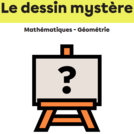
Le but de cette SAÉ est de s’exercer à identifier et à placer des points sur un plan cartésien à quatre quadrants. À l’aide de coordonnées, les élèves devront tenter de reproduire le dessin d’un coéquipier.
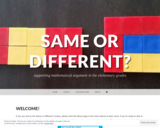
Same or Different? is a routine that provides students opportunities to construct arguments when comparing objects, such as numbers or shapes.
A routine like Same or Different? provides accessible opportunities for even youngest students to learn how to talk about various features of mathematical objects – quantity, shape, color, orientation, and arrangement, to name a few.

The main areas of focus in the second grade math curriculum are: understanding the base-ten system within 1,000, including place value and skip-counting in fives, tens, and hundreds; developing fluency with addition and subtraction, including solving word problems; regrouping in addition and subtraction; describing and analyzing shapes; using and understanding standard units of measure; working with money and time; and introducing multiplication.
The worksheets and printables for second grade math available on this page will enhance any classroom's math curriculum. These engaging second grade math worksheets cover the basics of counting and ordering as well as addition and subtraction, and include exciting introductions to geometry and algebra for future self-assurance in math.

This short video and interactive assessment activity is designed to teach fourth graders about selecting the incorrect statement.